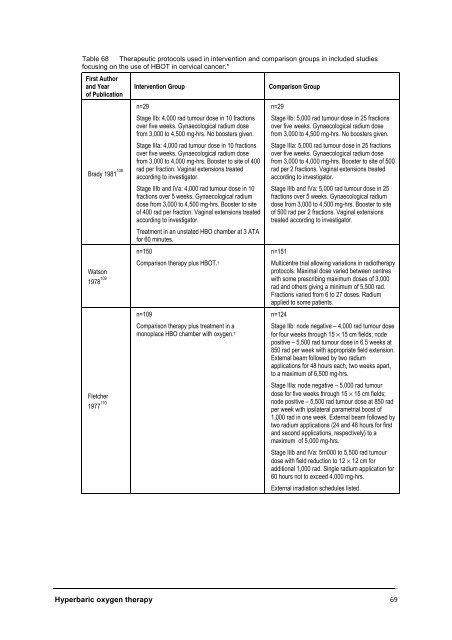Hyperbaric Oxygen Therapy - Hyperbaric Chamber Information ...
Hyperbaric Oxygen Therapy - Hyperbaric Chamber Information ...
Hyperbaric Oxygen Therapy - Hyperbaric Chamber Information ...
You also want an ePaper? Increase the reach of your titles
YUMPU automatically turns print PDFs into web optimized ePapers that Google loves.
Table 68 Therapeutic protocols used in intervention and comparison groups in included studies<br />
focusing on the use of HBOT in cervical cancer.*<br />
First Author<br />
and Year<br />
of Publication<br />
Intervention Group Comparison Group<br />
Brady 1981 108<br />
Watson<br />
1978 109<br />
Fletcher<br />
1977 110<br />
n=29<br />
Stage IIb: 4,000 rad tumour dose in 10 fractions<br />
over five weeks. Gynaecological radium dose<br />
from 3,000 to 4,500 mg-hrs. No boosters given.<br />
Stage IIIa: 4,000 rad tumour dose in 10 fractions<br />
over five weeks. Gynaecological radium dose<br />
from 3,000 to 4,000 mg-hrs. Booster to site of 400<br />
rad per fraction. Vaginal extensions treated<br />
according to investigator.<br />
Stage IIIb and IVa: 4,000 rad tumour dose in 10<br />
fractions over 5 weeks. Gynaecological radium<br />
dose from 3,000 to 4,500 mg-hrs. Booster to site<br />
of 400 rad per fraction. Vaginal extensions treated<br />
according to investigator.<br />
Treatment in an unstated HBO chamber at 3 ATA<br />
for 60 minutes.<br />
n=150<br />
Comparison therapy plus HBOT. †<br />
n=109<br />
Comparison therapy plus treatment in a<br />
monoplace HBO chamber with oxygen. †<br />
n=29<br />
Stage IIb: 5,000 rad tumour dose in 25 fractions<br />
over five weeks. Gynaecological radium dose<br />
from 3,000 to 4,500 mg-hrs. No boosters given.<br />
Stage IIIa: 5,000 rad tumour dose in 25 fractions<br />
over five weeks. Gynaecological radium dose<br />
from 3,000 to 4,000 mg-hrs. Booster to site of 500<br />
rad per 2 fractions. Vaginal extensions treated<br />
according to investigator.<br />
Stage IIIb and IVa: 5,000 rad tumour dose in 25<br />
fractions over 5 weeks. Gynaecological radium<br />
dose from 3,000 to 4,500 mg-hrs. Booster to site<br />
of 500 rad per 2 fractions. Vaginal extensions<br />
treated according to investigator.<br />
n=151<br />
Multicentre trial allowing variations in radiotherapy<br />
protocols. Maximal dose varied between centres<br />
with some prescribing maximum doses of 3,000<br />
rad and others giving a minimum of 5,500 rad.<br />
Fractions varied from 6 to 27 doses. Radium<br />
applied to some patients.<br />
n=124<br />
Stage IIb: node negative – 4,000 rad tumour dose<br />
for four weeks through 15 × 15 cm fields; node<br />
positive – 5,500 rad tumour dose in 6.5 weeks at<br />
850 rad per week with appropriate field extension.<br />
External beam followed by two radium<br />
applications for 48 hours each, two weeks apart,<br />
to a maximum of 6,500 mg-hrs.<br />
Stage IIIa: node negative – 5,000 rad tumour<br />
dose for five weeks through 15 × 15 cm fields;<br />
node positive – 5,500 rad tumour dose at 850 rad<br />
per week with ipsilateral parametrial boost of<br />
1,000 rad in one week. External beam followed by<br />
two radium applications (24 and 48 hours for first<br />
and second applications, respectively) to a<br />
maximum of 5,000 mg-hrs.<br />
Stage IIIb and IVa: 5m000 to 5,500 rad tumour<br />
dose with field reduction to 12 × 12 cm for<br />
additional 1,000 rad. Single radium application for<br />
60 hours not to exceed 4,000 mg-hrs.<br />
External irradiation schedules listed.<br />
<strong>Hyperbaric</strong> oxygen therapy 69



